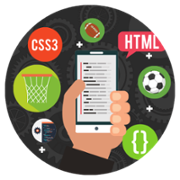STEM & Sports: A Slam Dunk for Education Equity
By Jill Denner & BA Laris | April 26, 2022
We all know that sports and other physical activities have health benefits. But did you know that they can also increase students’ interest and learning in science, engineering, technology, and math (STEM)? ETR and our partners at dfusion Inc are excited to be at the intersection of these two different but complementary fields. See our press release about our new app that research shows increases math and science knowledge and interest.
These ideas have been around for a while. Science museums have had sports exhibits for decades, such as the “Sports Challenge” at the Carnegie Science Center in Pittsburg which teaches the physics of hitting a baseball, and “Sports Science” at the Exploratorium in San Francisco which has exhibits such as the aerodynamics of bicycling. Many parents have watched their children learn math and statistics to be able to follow their favorite sports players and teams (remember the book and movie Moneyball?)
There is also a growing number of STEM-related activities led by professional sports teams from baseball, football, hockey, soccer, and more. We love major league baseball team Arizona Diamondbacks’ STEM Field Days, and Code.org’s partnership with the Jaffna Stallions to show the relevance of computer science to cricket. A recent Newsweek article does a nice job of describing other activities.
How to Facilitate STEM Learning
Across these different types of sports and different STEM concepts, we believe there are three essential elements that facilitate learning:.png)
- Real-world relevance (most children are familiar with sports)
- Equity (sports appeals to a range of children including those who play and watch)
- Motivation (many children will be motivated to learn STEM to understand or improve their own sports)
Watch our free “3 in 30” webinar for more detail from experts in the field who explain what can happen when you combine STEM and sports.
Scientific Research Supporting STEM and Sports
At ETR, science is foundational, so we looked at whether research shows that combining sports and/or physical activity with STEM benefits youth. We dug into the existing research (74 papers!) and found some evidence that adding in elements of sports and other physical activity can increase students’ interest in STEM by helping them see the relevance and improve students’ math learning by making a physiological or cognitive connection with learning. Here are a few exciting examples:
- 4th grade students who participated in vigorous physical activity at an urban public school over six weeks increased cognitive function resulting in improved math performance (Vetter et al., 2020).
- Incorporating analytics into basketball training clinics for 7th-12th grade basketball players resulted in students seeing the value of math and increased interest in STEM (Drazan et al., 2017).
- A 4-day basketball camp for middle school students that included basketball training, jump plate facilitation, data collection, speakers, and group-based projects led to increased STEM identity including their familiarity, perceived importance and interest in STEM and medicine (Marshall et al., 2020).
- A 3-hour evening workshop with middle and high school athletes where they collected data and built models of their own movement offered opportunities for students to think about and generate interest in machine learning (Zimmermann-Niefield et al., 2019).
- In a randomized control study of the STEMadium app, students significantly, improved their math and science knowledge and had a smaller decline in math skills during non-school periods (“summer slide”) compared to those who did not play the game. Students really like the game, and it worked equally well across genders (Kuhn & Denner, 2021).
STEM and Sports Curriculum
STEM Sports® curriculum is a fun and novel way to introduce motor skills, spatial awareness, and movement patterns to students. When applicable, the lessons have been aligned with national education standards, making this curriculum great to use in the classroom.
Here are just a few of the great student activities:
- Teaching students how to calculate their own field goal percentage, just like the greatest players in the NBA
- Gaining the understanding of energy and motion differences between a youth football and a foam football
- Learning how active play correlates with burning calories
- Discovering the technology behind optimal serving speed
Additional STEM and Sports Opportunities
Want to get your kids or students excited about STEM through sports? Check out these great options:
- Check out the STEMadium app, an evaluated app that teaches math and science through fun baseball-themed games and challenges.
- Visit a Science Museum in person or online:
- Sport Science at the Exploratorium (San Francisco CA)
- Highmark SportsWorks® - Carnegie Science Center (Pittsburg PA)
- Science of Sports Exhibit at the Cincinnati Museum Center (Cincinnati OH)
- Sports & Leisure - National Museum of American History (Washington DC)
- Sportsology Exhibit at the Science Museum of Minnesota (St. Paul MN)
- SportsZone Exhibit | The Franklin Institute Science Museum (Philadelphia)
- Attend STEM events and camps hosted by professional sports organizations
- Tell your school or out-of-school program about these curricula and programs
- Tell your school or community program about corporate special promotions and resources to connect STEM and sport.
Jill Denner (she/her/hers) is a Senior Research Scientist at ETR. She partners with schools, colleges, and community-based organizations to do research on broadening participation in computing and other STEM fields.
BA Laris (she/her/hers) is a Senior Program Manager at dfusion Inc. She partners with researchers, educators, and developers to create innovative and fun technology to promote youth interest and motivation in STEM through sports and physical activity.




